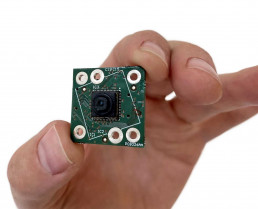Meet us at CES 2023
Meet us at CES 2023 where we will unveil a world premiere in smartphone photography. Book a demo and stay tuned how we will cure color blindness in smartphone cameras.
Book an appointment at ces2023 @ spectricity.com.
Spectricity receives €3 million grant from Flanders Innovation & Entrepreneurship (Agentschap Innoveren & Ondernemen - VLAIO)
We are pleased to announce that Spectricity has been awarded a €3 million grant by Flanders Innovation & Entrepreneurship (Agentschap Innoveren & Ondernemen - VLAIO) to help prepare Spectricity’s spectral sensor R&D for mobile devices. VLAIO stimulates innovation in Flanders and finances R&D driven by entrepreneurial Flemish companies.
Our CEO, Vincent Mouret, said:
“Flanders Innovation and Entrepreneurship has supported Spectricity since the beginning and has been instrumental in our research and development trajectory. With the new grant, VLAIO will help us accelerate our research on advanced consumer camera modules and AI to enable smartphone market areas. This takes us closer to achieving our objective of supporting mass adoption of spectral sensing in mobile devices.”
Spectricity Deploys Proprietary Technology at X-FAB to Bring Spectral Imaging to Mobile Devices
Enabling integration of small, pixelated spectral filters on CMOS image sensors
Tessenderlo and Mechelen, Belgium – June 28, 2022
X-FAB Silicon Foundries SE, the leading analog/mixed-signal and specialty foundry, and Spectricity, a fabless semiconductor company specializing in the development of multispectral imaging technology have collaborated on a unique imaging solution. Proprietary spectral imaging technology from Spectricity has been installed at X-FAB’s high-volume manufacturing facilities. This will, for the first time, enable low-cost manufacturing of spectral image sensors for use in mobile devices.
Spectricity’s patented spectral sensor solution is based on the integration of small, pixelated spectral filters onto CMOS image sensors in the visible and NIR spectral range. Inclusion of 16 or more high-quality narrowband channels is possible. Through its deployment, X-FAB is the only foundry enabling volume CMOS production of such small spectral pixels, making it and Spectricity well positioned to meet the demands of the mobile handset OEMs. The compactness and high spectral density of the resulting solution provides both high spatial- and spectral resolution sensing – allowing opportunities in smartphone, IoT, healthcare and wearables to be addressed.
Incorporation of spectral camera modules into mobile devices is part of an ongoing trend to add advanced sensing functionality. Spectral imagers will be able to capture image data across many spectral channels, beyond the conventional red, green and blue color channels. This will allow measuring of objects’ spectral signatures. Among the applications that will benefit are image acquisition where more accurate auto white balancing is needed, personalized cosmetics and skincare, remote healthcare, and smart gardening/agriculture.
According to Vincent Mouret, CEO of Spectricity: “Successful installation of our technology, which was originally pioneered by imec, at X-FAB’s volume production facilities is a key milestone for Spectricity in our ambition to serve the global smartphone market. This takes us closer to achieving our objective of supporting mass adoption of spectral sensing in mobile devices.”
Jörg Doblaski, CTO of X-FAB, comments: “We have been really impressed with the engineering skills of the Spectricity team, and are excited about the successful cooperation with an innovative European company enabling spectral imager products. Transfer of their technology has been accomplished within a short timeframe, with initial lots already meeting the required specifications.”
Spectricity plans to start sampling its spectral imaging solution fabricated via X-FAB later in 2022.
###
About X-FAB
X-FAB is the leading analog/mixed-signal and MEMS foundry group manufacturing silicon wafers for
automotive, industrial, consumer, medical and other applications. Its customers worldwide benefit from the
highest quality standards, manufacturing excellence and innovative solutions by using X-FAB’s modular
CMOS and SOI processes in geometries ranging from 1.0 µm to 130 nm, and its special silicon carbide and
MEMS long-lifetime processes. X-FAB’s analog-digital integrated circuits (mixed-signal ICs), sensors and
micro-electro-mechanical systems (MEMS) are manufactured at six production facilities in Germany, France,
Malaysia and the U.S. X-FAB employs about 4,000 people worldwide. Learn more at xfab.com.
About Spectricity
Spectricity is a fabless company headquartered in Belgium developing and manufacturing spectral sensing
solutions using CMOS technologies. These solutions are designed for high-volume production, and targeted
at use in consumer and mobile devices. The company was incorporated in 2018, and is backed by venture
capital investment. Its technology builds on an exclusively-licensed patent portfolio from imec, a world-
leading R&D and innovation hub in nano-electronics and digital technologies. The technology and the
products powered by it are the fruit of more than 15 years of research and development. Learn more
at spectricity.com.
Meet us at Image Sensors Europe
Spectricity will be presenting. Come and meet us on May 10th.
https://www.image-sensors.com/image-sensors-europe
Meet us at Sensors International
Spectricity will be presenting. Come and meet us on Wednesday November 10th.
https://sensorsinternational.net/
Coverage on Kanaal Z (Dutch/French only)
Kanaal Z publishes a nice video on Spectricity’s investment round and technology.
Spectricity Raises €14 Million Series B Funding as it Accelerates Plans to Deliver Industry Leading Hyperspectral Sensing to Mobile and Consumer Devices
Funding Expands Growth for Tiny Chip-size Sensors for Unimaginable New Applications
Mechelen, Belgium, August 3, 2021 – Spectricity, a leading provider of hyperspectral sensing solutions for mobile and consumer devices, announced today a €14 million ($16M US) Series B funding round to further accelerate the development and mass production of hyperspectral sensors and imagers for high-volume, low-cost applications from wearables to smartphones and IoT devices.
Hyperspectral sensing allows devices to “see” beyond what the naked eye can see. The sensor can tell you your heartbeat, the amount of oxygen in your blood or the hydration of your skin, while hyperspectral imagers can be used to perfectly match your skintone to cosmetics or to determine whether your food is fresh. Spectricity’s patented, spectral sensing technology is the only one in the world that can make professional grade sensor and imager solutions small and low power enough to fit a smartphone or a wearable device. This unique technology will bring a wide array of health, cosmetic, food and augmented reality applications to the pockets and/or the wrists of the consumers.
Leading global investors including AtlanticBridge, Capricorn Fusion China Fund, and Shanghai Semiconductor Equipment and Material Fund (SSMEF) invested in this Series B round alongside Belgium Series A investors imec.xpand and XTRION. This round brings Spectricity to €20 million in total funding to date.
“This is a major milestone for Spectricity and the deployment of our chip size hyperspectral sensor and imager solutions for mass market mobile devices and applications,” said Vincent Mouret, CEO of Spectricity. “This new round of financing will enable us to significantly accelerate our high-volume manufacturing, hire key talent and continue to expand our partnerships.”
Peter Vanbekbergen, partner at imec.xpand said: “The formation of Spectricity is a prime example of remarkable semiconductor innovation born in Europe, based on unique technology developed at imec. The best companies start with a great technology base, with founders coming together to identify a big problem and line up an expert investment team to help them succeed. As part of that team, we’re focused on providing Spectricity with unique value and networking.”
According to a recent March 2021 paper on the compact spectrometer systems market, emerging chip-size spectrometers are going to fuel growth to more than 300 million chips per year in 2024. New type spectrometers will be as small as semiconductor chips. (1)
“I am pleased to see Spectricity growing and closing their second financing round, three
years after its creation as imec spin-off,” said Luc Van den hove, President and CEO of imec. “Spectricity’s products are based on unique imec technology, and we will continue to maintain a strong link between our R&D and Spectricity’s development to enable a lasting competitive edge for Spectricity’s products.”
Following more than 10 years of research at imec, a world-leading R&D and innovation hub in nano-electronics and digital technologies, Spectricity was founded in 2018 by a team including research engineers of imec. Semiconductor industry veterans, CEO Vincent Mouret who joined the company last April and Chairman of the Board, Pieter Vorenkamp, ex-Senior Vice President of Broadcom, helped to productize the technology and scale the company.
About Spectricity
Spectricity is a fabless semiconductor company creating spectral sensing solutions for high-volume mobile and consumer devices, using low-cost CMOS technologies. Spectricity’s patented, spectral sensing technology enhances existing camera sensors by fusing data with other image and 3D sensors in the devices to provide augmented real-time data, advanced user-environment interfacing, and big data analysis. Spectricity’s miniaturized sensors enable completely new unimaginable applications from skin health to skin cosmetics and agricultural, AR, food analysis and more. www.spectricity.com
_________








